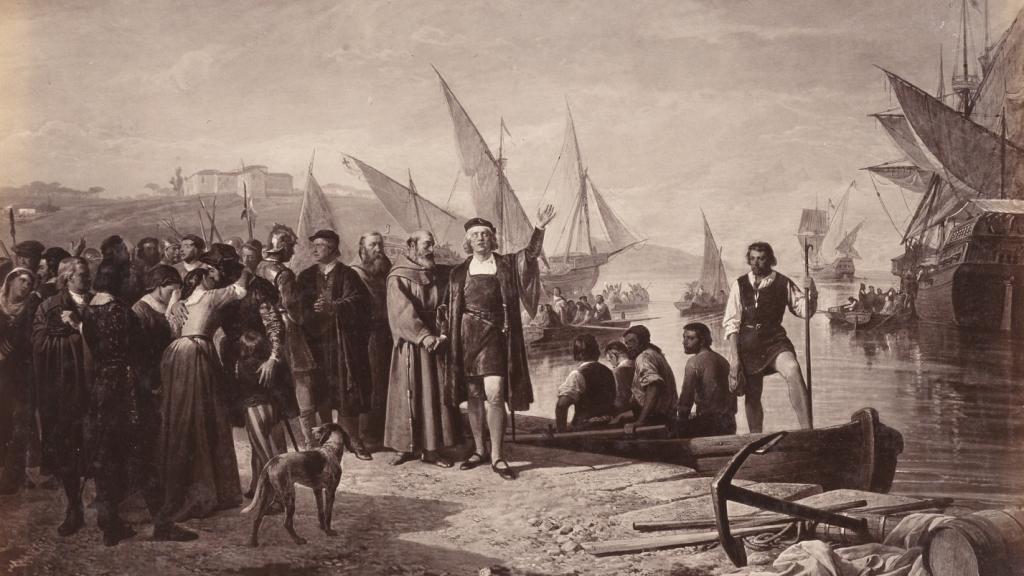At the end of the Granada war, the main objectives of Ferdinand the Catholic They seemed focused on consolidating the dynasty in Aragon and operations in the Mediterranean, but together with the queen Isabella of Castile decided then to support and finance the project Christopher Columbus of sailing towards the West in search of the Indies and their riches. “Even for an imaginative politician like him, it seems to go too far to promote an adventure as inconsistent and technically dubious as the one posed to him by a wandering Genoese who had failed to attract Portuguese attention,” assesses historian José Ángel Sesma Muñoz in his biography of the sovereign.
Whether it was due to the rejection of the exploratory enterprise expressed by the Portuguese rivals or the threat that the admiral would sell his plan to France or England, the truth is that at the moment of euphoria over the military triumph the Catholic Monarchs gave the green light to the trip. Columbus used a series of mystical-economic tricks to seduce the monarchs, among which the most notable was dedicating any profits to organize a new crusade: the conquest of Jerusalem.
This was later stated by the Genoese navigator himself in his Discovery Diary: “and he says that he hopes in God that upon his return from Castile he intended to find a barrel of gold.” […] and that they had found the gold mine and the spice store and that in such quantity that the kings before three years undertook and prepared to go to conquer the Holy House, that thus (he says) I protested to Your Highnesses that all the profit of this my enterprise would be spent on the conquest of Hierusalem (sic)”.
Portraits of Christopher Columbus and Ferdinand the Catholic.
The ambitious Genoese had been hanging around the court of Isabella and Ferdinand since the early 1480s and explaining his Atlantic project. He was aware, writes the historian Fernando Cervantes in Pathfinders (Turner), that to the monarchs of Castile and Aragon “the exploration per se It seemed very good to them, but what they really needed was money: access to the lucrative markets of Asia, rich in gold and spices.”
The conquest of the Nasrid kingdom of Granada, certified on January 2, 1492, not only made this demand for resources more pressing; Also, at the culmination of several centuries of struggle, he convinced these peninsular kingdoms that they had been entrusted with the divine mission to protect Christianity of the Islamic threat.

Christopher Columbus asks permission from the príor of La Rábida to go discover America.
Prado Museum
Commerce and God ran along the same path, especially in the mind of Ferdinand the Catholic: a fervent devotee, like any ruler of the time, he dreamed of conquering Jerusalem. It was not an absurd aspiration, since he had inherited the legitimate right to the title of king of Jerusalem after his grandfather, Alfonso V the Magnanimous, conquered Naples, a crown that received tribute from the holy city, in 1443. To make matters worse, an Aragonese humanist from the 13th century had predicted that the kings of Aragon were destined to take the mythical square by force.
As a seasoned adventurer, Christopher Columbus managed to enlist the support of influential groups of royal and financial intermediaries, many of them compatriots, to raise the sails of his caravels. And he especially tempted Ferdinand the Catholic with said candy: “The project could include plans to return to Spain through Jerusalem, thus opening a rear attack route“explains Cervantes, a professor at the University of Bristol specialized in Early Modern America. “From this perspective, Columbus raised the long-awaited support of Isabella and Ferdinand for his project as an act of gratitude to God for the victory of Granada“.
[Gloria y miserias de los conquistadores españoles: “El Nuevo Mundo los depredó antes a ellos”]
The final agreement between the sovereigns and the navigator was reflected in the Capitulations of Santa Fe, which included a series of surprising recognitions for Columbus in the hypothetical case of the success of his voyage: the title of admiral with a life-long character and hereditary transmission, he was named viceroy and governor general of any discovered territory and would correspond to one tenth of all the wealth or merchandise obtained, in addition to the right to exercise jurisdiction in disputes arising from commercial exploitation and the privilege to participate with one eighth in all commercial companies that negotiated with the new lands.
To resolve the complicated issue of financing, it was decided to hire a service endorsed by the monarchy, but which was paid for by individuals with which the Catholic Monarchs had their own agreements and adjustments. Specifically, the two million maravedíes for the expedition were contributed by businessmen and financiers from the kingdom of Aragon. “The fact that ultimately, including the financing formula, fell to the Aragonese officials, could be due to the fact that it was they who closed the State negotiation with the admiral and because they were less exposed to Portuguese interference,” concludes Sesma Muñoz. Columbus’s crusade failed because he did not reach the Indies by sailing west, but rather discovered another continent.
The post The fantastic move with which Columbus charmed the Catholic Monarchs to finance his trip appeared first on Veritas News.
